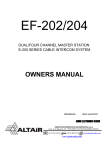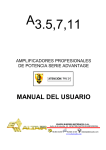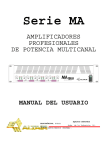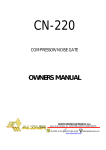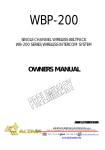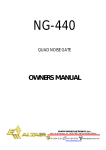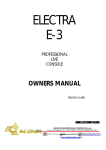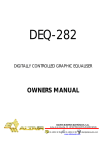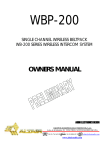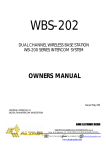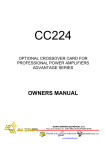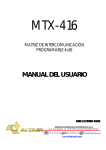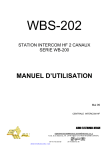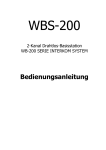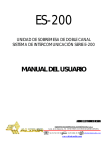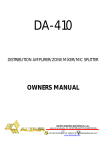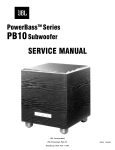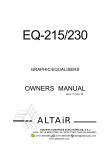Download OWNERS MANUAL -> ADVANTAGE SERIES
Transcript
A3.5,7,11 PROFESSIONAL POWER AMPLIFIERS ADVANTAGE SERIES NOTICE: PIN 2+ OWNERS MANUAL EQUIPOS EUROPEOS ELECTRÓNICOS, S.A.L Avda. de la Industria, 50. 28760 TRES CANTOS-MADRID (SPAIN). 34-1-804 32 65 34-1-804 43 58 [email protected] www.altairaudio.com 2 PROFESSIONAL POWER AMPLIFIERS ADVANTAGE SERIES CONTENTS 1. INTRODUCTION 2. SWITCHES, INDICATORS, ATTENUATORS AND CONNECTORS FRONT PANEL REAR PANEL 3. WORKING PRECAUTIONS 4. INSTALLATION UNPACKING MOUNTING CHANGING THE FUSE CONNECTING TO THE MAINS INPUT CONNECTION UNBALANCED INPUT BALANCED INPUT OUTPUT POWER CONNECTION. MODES OF OPERATION STEREO MODE OPERATION BRIDGE MODE OPERATION EARTH LINK 5. OPERATION POWER UP INPUT ATTENUATORS CLIP INDICATORS (INPUT SIGNAL OVERLOAD) SIGNAL INDICATORS ON/PROTECT INDICATORS FAN LOAD IMPEDANCES MAINTENANCE AMPLIFIER CONDITIONS 6. SPECIAL OPERATIONS INPUT SENSITIVITY/GAIN ADJUST LIMITER ON/OFF CHANGING THE MAINS VOLTAGE 7. DISTRIBUTED SYSTEMS APPLICATION (PUBLIC ADDRESS) 8. OPTIONAL CROSS-OVER CARD 9. TECHNICAL SPECIFICATIONS 10. GRAPHS 11. WARRANTY 3 4 4 4 5 5 5 6 6 7 7 8 9 9 10 11 11 12 12 12 12 13 13 14 14 14 14 15 17 17 18 19 19 20 21 22 PROFESSIONAL POWER AMPLIFIERS ADVANTAGE SERIES 3 1. INTRODUCTION Congratulations on your purchase of the ALTAIR power amplifier ADVANTAGE series. Our dilated experience in the design and manufacture of audio power amplifiers has led us to carry out a series of general purpose bipolar power amplifiers of great performances. There is a lot the characteristics that make of the ALTAIR power amplifiers ADVANTAGES series, one of the most highlighted of the audio professional market, here enumerated some: Multiple protection Has improved the circuits of DC output protection by relay. Guiding directly the power transistors output to the loudspeakers binding post has improved several qualities of the signal quality, the damping factor and the global reliability. Equally, the conventional thermal switches (based on contacts) has been substituted of the power modules by solid state sensors whose information completes the double condition of speed fan control and discharge the thermal protection. All the protection situations are displayed in the power amplifier front panel. Clipping circuit limiter Since most of the damage caused to loudspeakers, and even to the power amplifiers, is normally the result of the permanence of the power unit during long periods of time in clipping, it is necessary to have limiter mechanisms that assure their reliable operation. For this purpose, all the ADVANTAGE series power amplifiers has a "soft-clipping" circuit that acts on the output power by comparing the input and output signals. Once it detects a distortion or other noticeable cut, it stabilises the integrity of the output signal thereby avoiding overloading and saturation levels that might damage the system. This limiter effect is switchable on or off internally. Under control The conception of the new loudspeakers, especially the uses for low frequencies is based on that the amplifiers that govern them behave as ideal voltage amplifiers, is say with zero output impedance. The ADVANTAGE series approaches to this value nearly zero presenting a damping factor better than 300 what redounds in a perfect control of the loudspeaker voice coil position along their excursion. Naturally, you want to use your power amplifier just now, but before beginning is important that you read this manual. This manual will help you to install and use your new power amplifier. It is very important that you read it carefully, mainly the paragraphs marked as NOTE, PRECAUTION and DANGER, for your security. Save the original packing, you can re-use it to transport the power amplifier. NEVER SHIP THE POWER AMPLIFIER WITHOUT THE ORIGINAL PACKING. PROFESSIONAL POWER AMPLIFIERS ADVANTAGE SERIES 2. SWITCHES, INDICATORS, ATTENUATORS AND CONNECTORS. These are the switches, indicators, attenuators and connectors that you could find in your power amplifier. The description and explanation of each one, you will find it in the corresponding section. FRONT PANEL: CH-1 -15 dB -9 -3 -30 CLIP A 11 CH-2 -15 dB -20 -20 -9 -30 -3 SIGNAL ON/PROT CLIP -oo 0 -oo SIGNAL ON/PROT 0 1 0 INPUT ATTENUATOR. COOLING VENTS INPUT SIGNAL OVERLOAD INDICATOR. CLIP SIGNAL SIGNAL INDICATOR. ON/PROT TURN ON / PROTECT INDICATOR. 1 0 POWER SWITCH. REAR PANEL: BINDING POST. FUSE HOLDER. MAINS CORD. COOLING VENTS 4 PROFESSIONAL POWER AMPLIFIERS ADVANTAGE SERIES 5 EARTH LINK SWITCH. INPUT SIGNAL CONNECTOR XLR-3-31. STEREO/ BRIDGE SWITCH. XLR-3-32 OUTPUT SIGNAL CONNECTOR. (ONLY WITH THE OPTIONAL CROSSOVER CARD FITTED). INPUT SIGNAL SELECTOR FOR EACH CHANNEL. (ONLY WITH THE OPTIONAL CROSSOVER CARD FITTED). 3. WORKING PRECAUTIONS The manufacturer cannot be held responsible for any damage that is incurred by not using the power amplifier in compliance with the warranty or working precautions. DANGER: High voltage inside the amplifier. ! Do not open !. The power amplifier doesn't contain parts that can be repaired by the user. The power amplifier could have electric power stored in their interior even disconnected it from the mains. CAUTION: Protect the power amplifier from the rain and moisture. Ensure that no objects or liquids enter it. If liquid is spilled into the power amplifier, disconnect the power amplifier from the mains and consult a qualified service technician. Don't place the power amplifier close to sources of heat. Also make sure that the front and the rear panel there are free of obstructions, since the fan could not work properly and cause the thermal protection work. DANGER: The power amplifier output connectors could have high voltage. Make sure of turning off the power amplifier before handling on these output connectors. 4. INSTALLATION UNPACKING Before leaving from factory, each power amplifier was carefully inspected and tested. Unpack and inspect the power amplifier for any damage that may have occurred during shipment. If any damage is found, doesn't connect the power amplifier to the mains, notify the salesperson immediately, because the unit must be inspected by a qualified service technician. PROFESSIONAL POWER AMPLIFIERS ADVANTAGE SERIES 6 Save the original packing, you could use if you need to transport the power amplifier. NEVER SHIP THE POWER AMPLIFIER WITHOUT IT'S ORIGINAL PACKING. MOUNTING It is always advisable to mount the power amplifiers in rack, either for mobile or fixed installations, for protection, safety, aesthetics, etc. The ADVANTAGE series power amplifiers are designed for standard 19" rack mounting, and occupy 2u high rack space. Due to the weight of the unit, it should be securely fastened at the front and the back of the cabinet. If the racks are carriage ones, it is advisable that have trays in order to allow the power amplifier to rest on its base and in an elastic cradle, if possible. It is advisable, leave a separation space between amplifiers and other units in order to facilitate its cooling, upon mounting the amplifier in a rack. In the mounting, either fixed or in rack, the cooling vents placed in the front and rear panel should be free, so that the air circulates freely, and the amplifier could have a better heat dissipation. In the same way, make sure that there are no heat sources near the front cooling vent, because the fan exhaust cool air through this vent. CHANGING THE FUSE The power amplifiers are designed to work with slow blow type fuses of 6x32, whose values in order to work with a mains voltage of 230V 50-60 Hz or 115V 50-60 Hz. are specified in the following list: MODEL A3.5 A7 A11 FUSE (230V. 50-60 Hz) T5A. T6A. T8A. FUSE (115V. 50-60 Hz) T8A. T12A. T16A. Make sure that the power amplifier is disconnected from the mains. At the power amplifier rear panel is placed the fuse holder. Unscrew the most external part of the fuse holder. Upon unscrewing the most external part of the fuse holder, the fuse will appear. Remove it and change for a new one. Never use other type of element than a fuse. Screw the external part of the fuse holder. CAUTION: Always make sure upon changing the fuse, that this is the adequate. PROFESSIONAL POWER AMPLIFIERS ADVANTAGE SERIES 7 CONNECTING TO THE MAINS The connection of the power amplifier to the mains takes place by means of a three-wire cord provided by the factory. The European standard colour code is: Brown-Live, Blue-Neutral and Yellow/Green-Earth, keeps in mind this mains configuration, whenever handle the power amplifier plug. In the connection of several devices to the same AC distribution board and extension cables, keeps in mind the maximum current of the power amplifier, and make sure that the mains connector, as well as the AC distribution board, are of enough current capacity, since could take place in the mains connector, and in the same AC distribution board a overheating, with the risk of fire and/or short circuit. The following list shows the maximum average current requirement of the different models of power amplifiers at normal music operation: MODELS A3.5 A7 A11 MAXIMUM CURRENT REQUIREMENT 2A. 4A. 6A. Make sure that the power amplifier power switch is at position 0 (turned off). Insert the male connector of the three-wire cable into the mains plug. Turn on the power amplifier power switch. Right now the power amplifier will turn on. CAUTION: Make sure that the mains voltage is the correct, as well as their fuse is the adequate. INPUT CONNECTION Each power amplifier's channel incorporates one XLR-3-31 female connector. The inputs are balanced, with a nominal impedance of 20 KΩ (10 KΩ unbalanced). The next list shows the input pins correspondence as A.E.S recommendation practice: PIN 1 PIN 2 PIN 3 INPUT CONNECTOR XLR-3-31 GND HOT (+) COLD (-) PROFESSIONAL POWER AMPLIFIERS ADVANTAGE SERIES 8 The input connection depends on two factors, the first is the type of input signal balanced or unbalanced, and the second the ground configuration of the sound source (floating or groundreferenced). The next pictures shows some of the different possibilities of connection, relying on the type of input signal, balanced or unbalanced and according to the ground configuration of the equipment (floating or ground-referenced). In the next diagrams, we use the following symbols: Sound source with mains cord without ground connection. Sound source with mains cord with ground connection. Sound source with the EARTH-LINK OFF. Sound source with the EARTH LINK ON. UNBALANCED INPUT: This type of connection will be used when the sound source doesn't provide balanced output. If it is possible, will be employed the connection type 1. 1) Using twin-lead shielded cable: Floating sound source ( or ) Ground-referenced sound source ( 2) or Using single conductor coax cable: Floating sound source ( or ) ) PROFESSIONAL POWER AMPLIFIERS ADVANTAGE SERIES Ground-referenced sound source ( or ) or ) 9 BALANCED INPUT: Floating sound source ( or Ground-referenced sound source ( ) OUTPUT POWER CONNECTION. MODES OF OPERATION Each channel includes a pair of five-way binding post. The red binding post is positive and the black is ground. Keep in mind the polarity upon connecting the speakers since changing the speaker polarity of a system reduces the total output power by the effect of the phase cancellations mechanisms. In the output connection it is necessary to keep in mind a series of important precautions in order to avoid an accidental short circuit or a possible damage in the equipment: Consider the power-handling capacity of your speakers before connecting it to the power amplifier. Equipos Europeos Electrónicos is not liable for damage occurred by the connection of speakers to the power amplifier with a nominal power lower that the power amplifier. Turn off the power amplifier and turn down the input attenuators, whenever takes place an output power connection. The output power connectors could have high voltage, with the rising danger of short circuit. PROFESSIONAL POWER AMPLIFIERS ADVANTAGE SERIES 10 Never put the output power connectors in parallel. This connection doesn't increase the power and could cause the break of the power amplifier. Do not connect the power amplifier output connectors to the output connectors of any other power amplifier. This connection could cause the break of one or both power amplifiers. Do not connect the output connector ground (black binding post) to any input connector ground (PIN 1 of the connector XLR-3-31). This could create a ground loop and could cause feedback oscillations. Use loudspeaker cables sizes capable to manage the output current of the power amplifier. The selection of a good loudspeaker cable, with a good quality and an adequate diameter is very important, and is one of the things that less is kept in mind. The next list shows the maximum output current of the power amplifiers according to the model: MODELS A3.5 A7 A11 MAXIMUM OUTPUT CURRENT 9A. 13A. 16,5A. There are many factors that determine the loudspeaker cable diameter: the length of the cable, the type of signal that is going to circulate for it, the output power of the power amplifier etc. A cable with high resistance reduces the damping factor, limiting the power amplifier capacity for controlling the speakers accurately. The possible output connections, depends on the configuration of the STEREO/BRIDGE mode switch on the rear panel: CAUTION: Do not change the configuration of STEREO/BRIDGE switch unless the power amplifier is first turned off. Before turn on the power amplifier, make sure that the mains, input and output connections are correct. If doesn't follow these recommendations, could cause a power amplifier and/or loudspeakers breakdown. STEREO MODE OPERATION: In this mode the two channels of the power amplifier are totally independent, so that the two input signals, and the two power outputs will be wiring independently. In order to configure the power amplifier in STEREO mode, turn the amplifier off, slide the STEREO/BRIDGE switch toward the left (as you face the rear panel), and wire the input and output connections according to the next picture: PROFESSIONAL POWER AMPLIFIERS ADVANTAGE SERIES 11 BRIDGE MODE OPERATION: In BRIDGE mode, the input should be inserted on the XLR CH! input connector. In this mode the power of the two channels will be added over a single load. The CH1 input attenuator controls both channels, remaining the CH2 input attenuator disabled. The output in BRIDGE mode, must be taken between both red binding post (positive load pole is the red binding post of CH1 and the negative load, the red binding post of CH2). To put the power amplifier in BRIDGE mode, turn the power amplifier off, slide the STEREO/BRIDGE switch toward the right (as you face the rear panel), and wire the input and output connections according to the following picture: EARTH LINK In some installations, it might be necessary to isolate the power amplifier input signal electric ground, from the system mains earth, in order to avoid ground loops, that could generate unwanted noises. For this reason, the power amplifier provides an EARTH-LINK switch placed at the rear panel to lift the mains earth from the power amplifier input signal electric ground. 12 PROFESSIONAL POWER AMPLIFIERS ADVANTAGE SERIES MAINS EARTH LINKED WITH THE P. AMPLIFIER INPUT SIGNAL ELECTRIC GROUND. MAINS EARTH LIFTED FROM THE P. AMPLIFIER INPUT SIGNAL ELECTRIC GROUND. CAUTION: Sometimes, lifting the mains earth, by using a ground-lift connector, cancels some hum noises on the audio system, but this is very dangerous and not advisable, because should any circumstance part of the mains signal is derived to the chassis, could cause a short circuit through our body, upon having eliminated one of the working precautions of the unit. For this circumstance, NEVER lifts the mains earth (use the EARTH-LINK switch of the unit) in order to avoid possible accidents. 5. OPERATION POWER UP 1 0 Plug in all input and output connectors (following the recommendations of the sections INSTALLATION - INPUT CONNECTION AND INSTALLATION - OUTPUT CONNECTION). Ensure that both power amplifier's input attenuators are turned fully counter-clockwise ( -∞ position). At this time you can switch on the power amplifier. Upon switch the power amplifier on, the delay turn on system takes place, that minimises the effect of the transient currents on the loudspeakers. In a few seconds, the delay turn on system stops working (a RELAY click will be listened) and the load is connected. When turning on a rack of power amplifiers they should be switched on individually. The practice of leaving all power amplifiers in a rack switched on and powering up the whole rack by connecting it to the mains is dangerous and likely it blows the mains fuse of the rack power supply, if with good approach, the rack has one. In a rack of power amplifiers, switch the power amplifiers on in a one by one basis. ON/PROT Note that upon switching the power amplifier on, the ON/PROTECT indicator lights red (indicating that the power amplifier is cutting the output signal), and after a few seconds this led changes to green and a RELAY click will be listened indicating that the power amplifier is connecting the output signal to the loudspeakers. At this time you can turn up the power amplifier input attenuators. INPUT ATTENUATORS Each power amplifier channel has an input signal attenuator, gauged. The calibration is measured between ±1 dBu relative to the scale. The input attenuators are independent for each channel in STEREO mode. In mode BRIDGE both channels depend on the CH1 input attenuator. CLIP INDICATORS (INPUT SIGNAL OVERLOAD) CLIP , illuminates when the power amplifier starts to saturate, moreover, if The CLIP red LED the limiter is ON, this LED indicates that the circuit limiter starts to work (for more information see 13 PROFESSIONAL POWER AMPLIFIERS ADVANTAGE SERIES CLIP section SPECIAL OPERATIONS- LIMITER CONFIGURATION). The CLIP indicators are independent in each channel, and indicate a real saturation, by comparing input and output continuously, and are independent of the mains voltage. CLIP The CLIP indicators also illuminates when there is an output short-circuit, whenever one input signal is being introduced to the power amplifier. To make the loudspeakers life longer, avoid this situation of overload during extended periods of time. If the input signal level is too high, don't turn the power amplifier limiter off, because it is an efficient protection for the loudspeakers. In general, the loudspeakers resist high peaks of instantaneous power, but when exposed to extended saturations they lose any guarantee of good operation. The saturation measuring circuit is sensitive to peaks; it has a quick attack time and a slow release time. SIGNAL INDICATORS SIGNAL The SIGNAL green LEDs illuminates when the output signal of the corresponding channel reaches 25 dBu before saturation. These LEDs indicate signal presence in the power amplifier input. This SIGNAL measurement circuit is sensitive to peaks; it has a quick attack time and a slow release time to indicate the average power. ON/PROTECT INDICATORS ON/PROT The ON/PROT LED indicates the connection or disconnection of the load from the power ON/PROT amplifier. These bi-colour LED ON/PROT illuminates in red when the load is disconnected from the power amplifier and it illuminates in green when the load is connected to the power amplifier. Therefore, whenever this indicator is in red, will indicate us that the load is disconnected from the power amplifier, and the power amplifier is not operative at that moment. This occurs when the power amplifier is turned on, and when the ERROR or THERMAL protections are activated. When the power amplifier output transistors reach 90ºC, the thermal protection circuit of the corresponding channel is activated. The thermal protection, disconnects the load from the power ON/PROT amplifier, turning red the ON/PROT LED of the corresponding channel. This only happens under the most severe conditions of continuous overload; in such a case, it is essential to localise and to rectify the cause of this overheating condition. The thermal protection circuit returns automatically to its normal operation when the power amplifier output transistors drops under the ON/PROT security level, connecting the load again, and turning green the ON/PROT LED . The power amplifier load protection circuit, work when a continuous voltage appears in the power amplifier output connectors, disconnecting the load from the power amplifier (the ON/PROT ON/PROT LED of the corresponding channel illuminates on red). When the continuous voltage disappear, the load protection circuit automatically, connects the load to the power amplifier, and ON/PROT the ON/PROT LED turns green. ON/PROT The power amplifier has two ON/PROT LED indicators, one per channel. PROFESSIONAL POWER AMPLIFIERS ADVANTAGE SERIES 14 FAN The power amplifier includes a thermally controlled system, which continuously regulates the fan speed depending on, the heat energy it has to evacuate. This variable speed circuit avoids abrupt changes of temperature and substantially extents the working life of the components builds in. At power amplifier turn on, the fan rotates at maximum speed, in order to exhaust the maximum dust possible. Soon after, the fan's speed drops to normal speed. The power amplifier fan rotates at maximum speed also, in an overheating situation (when a thermal protection is activated) so that the heat drops under the security level quickly. The fan is placed inside the power amplifier, and incorporates some cooling vents in the front and rear panel for which the air is evacuated, for that reason it is important make sure that the cooling vents are always free so that the air could circulate with freedom. LOAD IMPEDANCES The power amplifiers ADVANTAGE series, are designed to drive a 4Ω or higher load impedances in STEREO mode (8Ω or higher in Mode BRIDGE), without current limiting. When the power amplifier is working in BRIDGE mode, the load impedance must be 8Ω or higher, with the same consideration that in STEREO mode with 4Ω load impedance. This is because in BRIDGE mode, each channel is like driving with the half load impedance. MAINTENANCE Periodically, and in a technical service, you must clean the dust and dirt accumulated inside the power amplifier, especially in the heatsinks, the fan and the cooling vents, with a vacuum cleaner or with an air-compressor gun. The dirt diminishes considerably the capacity of radiation and ventilation. The input attenuators (potentiometers) are sensitive to the dust accumulated, and therefore for trouble free operation they must be cleaned with an air compressor gun or be changed if necessary. NOTE: Equipos Europeos Electrónicos don't recommend the use of spray cleaners because they could damage the lubricant layer of the potentiometers. Use compressed air to clean them or replace with similar parts. AMPLIFIER CONDITIONS INDICATORS AMPLIFIER CONDITION The power amplifier has just been turned on (it is still in the initial delay) and it is not receiving an input signal. In this case the ON/PROT indicators of both channels would be illuminated in red. OR A protection was activated (ERROR or THERMAL). The power amplifier is not receiving an input signal. In this case would be illuminated in red the ON/PROT indicator of the channel in which the protection has been activated. 15 PROFESSIONAL POWER AMPLIFIERS ADVANTAGE SERIES INDICATORS AMPLIFIER CONDITION The power amplifier has just been turned on (it is still in the initial delay) and it is receiving an input signal. In this case the ON/PROT indicators of both channels would be illuminated in red. OR A protection was activated (ERROR or THERMAL). The power amplifier is receiving an input signal. In this case would be illuminated in red the ON/PROT indicator of the channel in which the protection has been activated. The channel with this indicator status is not receiving an input signal, but is ready in order to receive it. Normal operation. The channel with this indicator status is receiving an input signal, and amplifying it. The channel with this indicator status is receiving an input signal too high. If the limiter is engaged, it will be working, and if it is not engaged, the output signal will be saturated. The channel with this indicator status has its output in short-circuit There is no power to the amplifier, either because it is not plugged or because the power switch is in the OFF position. INDICATORS RED: GREEN: 6. SPECIAL OPERATIONS In order to configure some of the power amplifier possibilities it is necessary to open it, removing the nine screws on the upper cover. NOTE: This type of operations takes place with the unit open, for what it should be carried out by a qualified technician. DANGER: Before opening the amplifier, disconnect it from the mains. It is important to indicate that although the unit is power out (with the power switch in 0 position), if it continues connected to the mains there are different parts of the unit that are subjected to high voltage. CAUTION: Protect the power amplifier from the rain and moisture, mainly if it is open. If liquid is spilled into the power amplifier, disconnect it from the mains and consult a qualified service technician. The input sensitivity and limiter configuration of both channels, takes place in the driver card, shown in the next figure (DRIVER A5/11 ALTAIR -081). This board is located parallel to the power amplifier bottom plate. The driver board is wide, occupying almost the whole width of the power amplifier. The input sensitivity configuration of both channels is close the XLR-3-31 of CH1, and the limiter configuration is close the XLR-3-321 of CH2. 16 SENS._CH1 0 dBu. S1 S2 SENS. 0 dBu. CH2 ON OFF J4 LIMITER PROFESSIONAL POWER AMPLIFIERS ADVANTAGE SERIES The voltage selector is placed in the left side of the power supply card, shown in the next figure (POWER SUPPLY A5/11 ALTAIR -082). The power supply card is located in the front-left side of the power amplifier, (as you face the front panel). PROFESSIONAL POWER AMPLIFIERS ADVANTAGE SERIES 17 INPUT SENSITIVITY/GAIN ADJUST The power amplifier input sensitivity may be configured with two resistors, one for each channel. When not installed this resistors, the input SENSITIVITY (input level necessary in order to produce the maximum output level) of the channel is 0 dBu, and with a resistor of 3K16 we obtain a input SENSITIVITY of +8 dBu. These are the two extreme values of the resistor to configure the input sensitivity. The factory configuration is with input sensitivity 0 dBu. Channel 1 Channel 2 The different resistors to obtain input sensitivities between 0 dBu and +8 dBu are show in the next table: INPUT SENSITIVITY 0 dBu (0,77 V). +1 dBu (0,87 V). +2 dBu (0,98 V). +3 dBu (1,10 V). +4 dBu (1,23 V). +5 dBu (1,38 V). +6 dBu (1,55 V). E+7 dBu (1,74 V).N(1/4W, +8 dBu (1,95 V). RESISTOR (1/4W, 1%) Without resistor. 42K2. 20K0. 12K1. 9K09. 6K81. 5K23. 4K02. 3K16. CAUTION: Never put a resistor to configure the input sensitivity less than 3K16. This can produce a misoperate of the power amplifier. The gain (times that the output signal is increased with respect to input signal), depends on the power amplifier model, as well as of the input sensitivity configuration. In the next table is shown the gains according to the power amplifier model and its input sensitivity configuration (with intermediate input sensitivities, subtract the gain corresponding to 0 dBu with the configured input sensitivity, and obtain the power amplifier gain i.e.: 36-6 = 30). MODELS A3.5 A7 A11 GAIN (dB) INPUT SENSITIVITY 0 dBu (0,775 V). +8 dBu (1,95 V). 31 23 34 26 36 28 LIMITER ON/OFF The power amplifier's limiter reduces the input signal when the power amplifier starts to saturate, which avoids high saturation and loudspeaker damage. 18 PROFESSIONAL POWER AMPLIFIERS ADVANTAGE SERIES It is very advisable use the limiter circuit. When the limiter ON/OFF switch is not pushed, the limiter is enable (ON). When this switch is pushed, the limiter is disable (OFF). The limiter configuration (ON/OFF) affects to both channels of the power amplifier. The factory configuration is with the limiter enable (ON) in both channels. LIMITER CONFIGURATION Configuration Switch position ON OFF J4 CH1 -> LIMITER ON. CH2 -> LIMITER ON. LIMITER ON OFF J4 CH1 -> LIMITER OFF. CH2 -> LIMITER OFF. LIMITER CHANGING THE MAINS VOLTAGE The power amplifier is set to operate at 230V, 50-60Hz or at 115V, 50-60Hz. Make sure that the power amplifier is disconnected of the mains. Set up the voltage selector, placed in the left side of the power supply card (POWER SUPPLY A5/11 ALTAIR -082), in the position that shows the voltage that you want to connect it. Power Amplifier set up 115 V. Power Amplifier set up 230 V. Make sure that the fuse is the right one for the selected voltage: MODEL A3.5 A7 A11 FUSE (230V. 50-60 Hz) T5A. T6A. T8A. FUSE (115V. 50-60 Hz) T8A. T12A. T16A. PROFESSIONAL POWER AMPLIFIERS ADVANTAGE SERIES 19 7. DISTRIBUTED SYSTEMS APPLICATION (PUBLIC ADDRESS) Currently, the standard of public address PA, uses loudspeakers of 70.7 Volts and 100 Volts with different powers. The professional power amplifiers ADVANTAGE series could work with these public address systems. In order to use the power amplifiers in distributed systems, it is necessary to choose the loudspeaker voltage operation (and therefore the power amplifier model) and wire the loudspeakers in parallel and then to the power amplifier output, always keeping in mind that the sum of the loudspeaker power placed in parallel with the power amplifier output should not never overcome the maximum acceptable power of the amplifier. The next table shows the voltages and powers to choose from. Note that both configurations are in Bridge mode so, never refer any loudspeaker to ground in the sound system installation. OUTPUT POWER Watts RMS 1KHz, THD+N 0,1% Bridge mode MODEL 70,7 V LINE 100 V LINE --A3.5 700 -A7 -1100 A11 8. OPTIONAL CROSS-OVER CARD. An optional crossover card is available as an option to be installed and configured by using a simple screwdriver. The card provides High and Low frequency crossover outputs of 24 dB/octave L-R type. Refer to its corresponding user manual for proper operation. 20 PROFESSIONAL POWER AMPLIFIERS ADVANTAGE SERIES 9. TECHNICAL SPECIFICATIONS MODEL OUTPUT POWER IN WATTS (RMS, 1KHz, THD < 0,1%) Stereo mode: (per channel, botch channel driven) 8Ω 4Ω Bridge mode: 8Ω Dynamic power EIA RS-490: 8Ω (Botch channels driven) 4Ω TOTAL HARMONIC DISTORTION (THD+N): INTERMODULATION DISTORTION INPUT SENSITIVITY: at rated output power (4Ω) INPUT IMPEDANCE: COMMON MODE REJECTION RATIO (C.M.R.R.): DAMPING FACTOR: HUM AND NOISE: ("A" weighted) FREQUENCY RESPONSE: OUTPUT SLEW RATE: CHANNEL SEPARATION: INPUT CONNECTORS PER CHANNEL: OUTPUT CONNECTORS PER CHANNEL: INDIDATORS: COOLING: PROTECTIONS: POWER SUPPLY: POWER REQUIREMENTS AT FULL OUTPUT: NET/SHIPPING WEIGHT: DIMENSIONS RACK MOUNTING: A3.5 A7 A11 100 200 300 175 350 550 350 700 1100 120 230 350 220 410 650 Less than 0,05% at rated output power at 1 kHz into 4 Ω. SMPTE: - Less than 0,08% at 60Hz, 7KHz, 4:1 ratio, into 4Ω. at rated output power. DIM-30: - Less than 0,04% into 4Ω. Internally selectable by means of resistor: From 0 dBv (0.775 V) to +8dBv (1.95 V). Balanced: 20 KΩ. Unbalanced: 10KΩ. Greater than 70 dB, 20 Hz to 10 KHz.; 90 dB at 50 Hz. Greater than 300 at 1 KHz into 8Ω. Greater than 100 dB, 20Hz to 20KHz ref. full output. 20 Hz to 20KHz (-0,5 dB). Typically 20 V/us. Greater than 65 dB at 1KHz. XLR-3-31 Balanced. Binding post. CLIP LED (one per channel). SIGNAL LED (one per channel). ON/PROT LED (one per channel). Forced air by continuous variable speed fan. Front to rear cooling. Electronic against short-circuit and open circuit. Thermal against output transistors overheats. DC out by relay. Delayed turn on/off Mains inrush transient. (A7, A11 only) 115/230 Volts + 10%, -30%, 50/60 Hz. 350 V.A. 700 V.A. 1100 V.A. 11 Kg. / 14 Kg. 14 Kg. / 17 Kg. 15 Kg. / 18 Kg. 483x89x370 m/m (19" x 2 u.). 430 m/m deep needed including external XLR's. NOTE: EQUIPOS EUROPEOS ELECTRÓNICOS S.A.L. reserves the right to modify the technical specifications without previous notice. PROFESSIONAL POWER AMPLIFIERS ADVANTAGE SERIES 10. GRAPHS A11: Typical common mode relation ratio (C.M.R.R.) versus frequency at rated output power. A11: Channel separation L -> R, R->L. A11: Frequency response at rated output into 4Ω. A11: Total harmonic distortion versus frequency at rated output power, into 4Ω. 21 PROFESSIONAL POWER AMPLIFIERS ADVANTAGE SERIES 22 11. WARRANTY This unit is warranted by Equipos Europeos Electrónicos to the original user against flaws in the manufacturing and in the materials for a length of time of one year, starting from the date of sale. Flaws due to misuse of the unit, internal modifications or accidents are not covered by this warranty. There is no other warranty expressed or implicit. Any faulty unit must be sent, to the dealer or the manufacturer. The serial number of the unit must be included with any request for the service. Equipos Europeos Electrónicos reserves the right to modify the prices or the technical specifications without notice. SERIAL NUMBER ................................................... EQUIPOS EUROPEOS ELECTRÓNICOS, S.A.L Avda. de la Industria, 50. 28760 TRES CANTOS-MADRID (SPAIN). 34-91-804 32 65 34-91-804 43 58 [email protected] www.altairaudio.com European Union Waste Electronics Information Unión Europea Información sobre residuos electrónicos Waste from Electrical and Electronic Equipment (WEEE) directive The WEEE logo signifies specific recycling programs and procedures for electronic products in countries of the European Union. We encourage the recycling of our products. If you have further questions about recycling, contact your local sales office. Directiva sobre Residuos de Aparatos Eléctricos y Electrónicos (RAEE) El logotipo de la Directiva RAEE se refiere a los programas y procedimientos específicos de reciclaje para aparatos electrónicos de países de la Unión Europea. Recomendamos el reciclaje de nuestros productos. Si tiene alguna consulta, póngase en contacto con su Distribuidor. Information based on European Union WEEE Directive 2002/96/EC Información basada en la Directiva de la unión europea RAEE 2002/96/EC y el Real Decreto 208/2005 AUDIO ELECTRONICS DESIGN EQUIPOS EUROPEOS ELECTRÓNICOS, S.A.L Avda. de la Industria, 50. 28760 TRES CANTOS-MADRID (SPAIN). 34-91-761 65 80 34-91-804 43 58 www.altairaudio.com [email protected]























